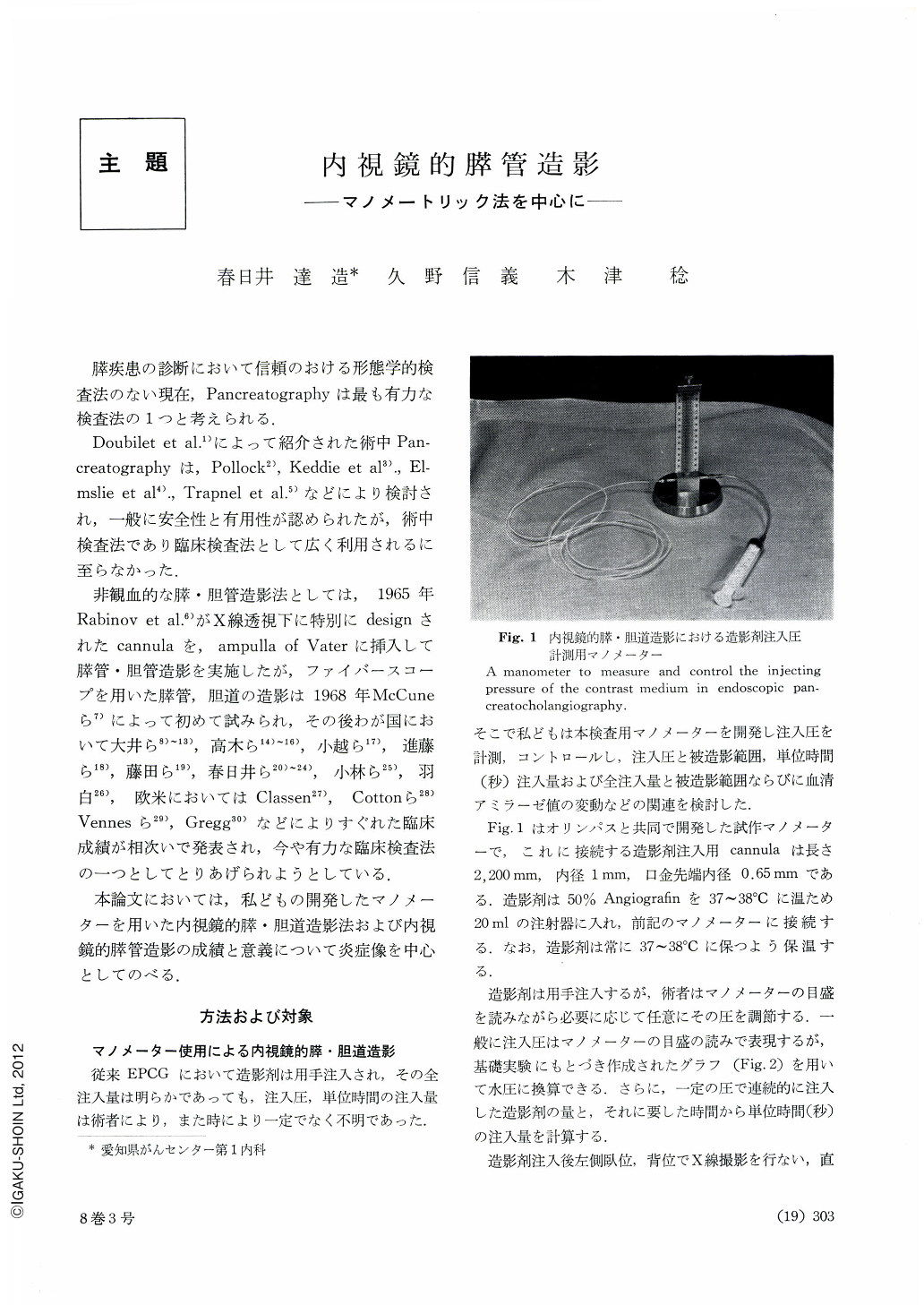Japanese
English
- 有料閲覧
- Abstract 文献概要
- 1ページ目 Look Inside
膵疾患の診断において信頼のおける形態学的検査法のない現在,Pancreatographyは最も有力な検査法の1つと考えられる.
Doubilet et al.1)によって紹介された術中Pancreatographyは,Pollock2),Keddie et a13).,Elmslie et al.4),Trapnel et al.5)などにより検討され,一般に安全性と有用性が認められたが,術中検査法であり臨床検査法として広く利用されるに至らなかった.
Out of 422 attempted examinations, 380 (90.0%) cannulatians were successfully performed resulting in 213 endoscopic pancreatograms, 130 endoscopic pan-creatocholangiograms and 37 endoscopic cholangiograms. The selected ducts were visualized in 87.4% of attempted cases.
1. Use of a manometer in endoscopic pancreatocholangiography (EPCG).
A manometer was developed by us to measure and control the injecting pressure of the contrast medium in EPCG. In EPCG or EPG (endoscopic pancreatography) sufficient opacification of all pancreatic ducts including fine pancreatic ducts and/or the biliary system including the intra hepatic bile ducts was obtained with a pressure of 90 to 100 mm of the manometer scale (370 to 560 mmH2O). In ECG (endoscopic cholangiography) a pressure of 80 to 100 mm was used. The total volume of injecting dye was 20 ml for EPCG, 10 to 20 ml for EPG and over 15 ml for EPG with an injecting speed of 0.2 to 0.4ml/sec.
2. Chronic pancreatitis and criteria for EPCG diagnosis of chronic pancreatitis.
Chronic pancreatitis was classified into 3 groups; minimal, moderate and advanced pancreatitis, according to grading of findings in EPCG. In 124 cases of chronic pancreatitis 48 showed minimal, 52 moderate and 24 advanced stages of chronic pancreatitis.
The criteria for EPCG diagnosis of chronic pancreatitis were evaluated by the study of postmortem pancreatograms and histological investigation. A correlation between both investigations was demonstrated in 79% of normal findings and in all cases of chronic pancreatitis diagnosed by postmortem pancreatograms. Histological study confirmed the accuracy of the postmortem pancreatogram diagnosis in 92% of cases diagnosed as minimal pancreatitis, 88% in moderate and 100% in advanced cases.
3. Carcinoma of the pancreas.
Seven cases of carcinoma of the head of the pancreas and 7 cases of pancreatic carcinoma located in the body and tail were diagnosed by EPCG. Findings of pancreatic carcinoma in EPG were characterized by stenosis and obstruction of the main pancreatic duct as well as sometimes by a filling defect in the pancreatic field formed mainly by the branches of the pancreatic duct and fine pancreatic ducts occasionally by acini. Obstructed type, stenosed type, mixed type, and pancreatic field defect type were encountered in decending order of frequency.
It appears that EPCG is one of the most reliable procedures to detect not only space occupying lesions but also chronic inflammatory changes in the pancreas.

Copyright © 1973, Igaku-Shoin Ltd. All rights reserved.


